| |
|
|
 |
| ROYAL PALACE |
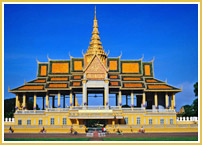 The Royal Palace has had some modifications to its buildings; some have also been demolished completely. The Throne Hall there today is actually not the original one King Norodom would have used when the palace was first built. The Silver Pagoda has undergone a tremendous face-lift with its tiles replaced and buildings given new paint. It has become a popular tourist attraction in Phnom Penh. Visitors are able to wander around the Silver Pagoda compound and the central compound containing the Throne Hall, however, they may not enter the Khemarin Palace compound. The Khemarin Palace compound is where Norodom Sihamoni, the present King of Cambodia currently resides. The Royal Palace has had some modifications to its buildings; some have also been demolished completely. The Throne Hall there today is actually not the original one King Norodom would have used when the palace was first built. The Silver Pagoda has undergone a tremendous face-lift with its tiles replaced and buildings given new paint. It has become a popular tourist attraction in Phnom Penh. Visitors are able to wander around the Silver Pagoda compound and the central compound containing the Throne Hall, however, they may not enter the Khemarin Palace compound. The Khemarin Palace compound is where Norodom Sihamoni, the present King of Cambodia currently resides.
|
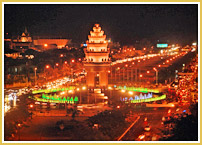 The Independence Monument (Vimean Ekareach) in Phnom Penh, capital of Cambodia, was built in 1958 following the country's independence from France. It stands on the intersection of Norodom Boulevard and Sihanouk Boulevard in the centre of the city. It is in the form of a lotus-shaped stupa, of the style seen at the great Khmer temple at Angkor Wat and other Khmer historical sites. The monument was designed by the influential Cambodian modern architect Vann Molyvann. During national celebrations—most notably, Independence Day—the monument is the center of activity. A ceremonial flame on the interior pedestal is often lit by a royal or high official on these occasions, and floral tributes line the stairs. Most of the year, however, the monument is visited by photo-taking tourists and locals looking for some quiet conversation. The Independence Monument (Vimean Ekareach) in Phnom Penh, capital of Cambodia, was built in 1958 following the country's independence from France. It stands on the intersection of Norodom Boulevard and Sihanouk Boulevard in the centre of the city. It is in the form of a lotus-shaped stupa, of the style seen at the great Khmer temple at Angkor Wat and other Khmer historical sites. The monument was designed by the influential Cambodian modern architect Vann Molyvann. During national celebrations—most notably, Independence Day—the monument is the center of activity. A ceremonial flame on the interior pedestal is often lit by a royal or high official on these occasions, and floral tributes line the stairs. Most of the year, however, the monument is visited by photo-taking tourists and locals looking for some quiet conversation. |
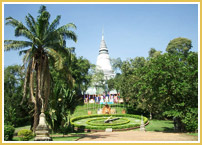 Wat Phnom is one of the most important pagodas in Phnom Penh. Built in 1373,it stands at 27 metres and is the tallest religious structure in the city. Built on an artificial hill by the wealthy widow Daun Chi Penh after a great flood washed statues of Buddha downstream, it has since been renovated. There have been many additions to the original shrines over the centuries. The largest stupa houses the ashes of King Ponhea Yat and it is the center of city celebration for the Cambodian New Year, and Pchum Benh. Wat Phnom is one of the most important pagodas in Phnom Penh. Built in 1373,it stands at 27 metres and is the tallest religious structure in the city. Built on an artificial hill by the wealthy widow Daun Chi Penh after a great flood washed statues of Buddha downstream, it has since been renovated. There have been many additions to the original shrines over the centuries. The largest stupa houses the ashes of King Ponhea Yat and it is the center of city celebration for the Cambodian New Year, and Pchum Benh. |
 The National Museum of Cambodia in Phnom Penh, capital of Cambodia, is the country's leading historical and archaeological museum. It houses one of the world's largest collections of Khmer art, including sculpture, ceramics, bronzes, and ethnographic objects. The Museum’s collection includes over 14,000 items, from prehistoric times to periods before, during, and after the Khmer Empire, which at its height stretched from Thailand, across present-day Cambodia, to southern Vietnam. The Museum buildings, inspired by Khmer temple architecture, were constructed between 1917 and 1924; the museum was officially inaugurated in 1920, renovated in part in 1968. The National Museum of Cambodia in Phnom Penh, capital of Cambodia, is the country's leading historical and archaeological museum. It houses one of the world's largest collections of Khmer art, including sculpture, ceramics, bronzes, and ethnographic objects. The Museum’s collection includes over 14,000 items, from prehistoric times to periods before, during, and after the Khmer Empire, which at its height stretched from Thailand, across present-day Cambodia, to southern Vietnam. The Museum buildings, inspired by Khmer temple architecture, were constructed between 1917 and 1924; the museum was officially inaugurated in 1920, renovated in part in 1968. |
|
| PHSAR THMEY/ YELLOW MARKET |
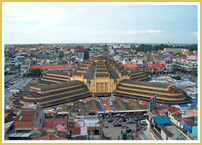 Phsar Thom Thmei is also known as central Market is a large market constructed in 1937 in the shape of a dome with four arms branching out into vast hallways with countless stalls of goods. It is located in Cambodia's capital city, Phnom Penh. When it first opened in 1937, it was said to be the biggest market in Asia, and today it serves as a fully functional historical market. The market opens from 7:00 AM to 5:00 PM, and it is, for tourists, a 'must see' stop. Most tourists visit this market because they want to see the extensive amount of products that are offered for bargain. The four wings of this gigantic yellow colored dome, Phsar Thom Thmei, are teeming with numerous stalls that sell goods ranging from gold and silver, antique coins, money exchange, men and women apparels, clocks, books, flowers, food, fabrics, shoes, souvenirs, fish, seafood, dessert, luggage, and countless other products. Phsar Thom Thmei is also known as central Market is a large market constructed in 1937 in the shape of a dome with four arms branching out into vast hallways with countless stalls of goods. It is located in Cambodia's capital city, Phnom Penh. When it first opened in 1937, it was said to be the biggest market in Asia, and today it serves as a fully functional historical market. The market opens from 7:00 AM to 5:00 PM, and it is, for tourists, a 'must see' stop. Most tourists visit this market because they want to see the extensive amount of products that are offered for bargain. The four wings of this gigantic yellow colored dome, Phsar Thom Thmei, are teeming with numerous stalls that sell goods ranging from gold and silver, antique coins, money exchange, men and women apparels, clocks, books, flowers, food, fabrics, shoes, souvenirs, fish, seafood, dessert, luggage, and countless other products.
This unique, art-deco building is a Phnom Penh landmark. Prior to 1935, the area was a lake that received the runoff during the rainy season. The lake was drained and the market begins its construction in 1935 and completed in 1937. Wet season flooding in the area around the market is a vestige evidence of the existence of the old lake. The entrance to the market is lined with souvenir merchants hawking everything from T-shirts and postcards to silver curios and kramas. Inside is a dazzling display of jewels and gold. Electronic goods, stationery, secondhand clothes and flowers are also in ample. |
|
| RUSSIAN MARKET |
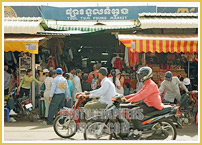 This is primarily a residential area at the southern of Phnom Penh. Phsar Toul Tum Poung (Russian Market) is perhaps the most important market for expatriates and a “must see” on any good tourist itinerary. This is primarily a residential area at the southern of Phnom Penh. Phsar Toul Tum Poung (Russian Market) is perhaps the most important market for expatriates and a “must see” on any good tourist itinerary. |
|
| MEKONG RIVER |
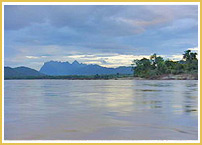 The Mekong is one of the world’s major rivers. It is the world's 12th-longest river and the 7th-longest in Asia. (Discharging 475 km3/ 114 cu mi of water annually). Its estimated length is 4,350 km (2,703 mi), and it drains an area of 795,000 km2 (307,000 sq mi). From the Tibetan Plateau this river runs through China's Yunnan province, Burma, Thailand, Laos, Cambodia and Vietnam. All these areas except China and Burma belong to the Mekong River Commission. The extreme seasonal variations in flow and the presence of rapids and waterfalls in this river have made navigation extremely difficult. The Mekong is one of the world’s major rivers. It is the world's 12th-longest river and the 7th-longest in Asia. (Discharging 475 km3/ 114 cu mi of water annually). Its estimated length is 4,350 km (2,703 mi), and it drains an area of 795,000 km2 (307,000 sq mi). From the Tibetan Plateau this river runs through China's Yunnan province, Burma, Thailand, Laos, Cambodia and Vietnam. All these areas except China and Burma belong to the Mekong River Commission. The extreme seasonal variations in flow and the presence of rapids and waterfalls in this river have made navigation extremely difficult. |
|
| MALLS/ SUPER MARKETS |
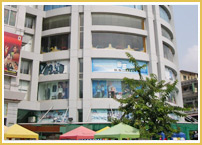 Sorya Shopping Center is a shopping mall in the Daun Penh District of Phnom Penh, it is one of the popular malls in Cambodia. It is a westernized shopping center and contains a number of fast food restaurants. Sorya Shopping Center is currently the largest modern shopping complex in Cambodia. Besides, there are still new buildings of the super markets in Phnom Penh, such as Bayon, Sovanna, Pencil, where you can get the information for your travelling. Sorya Shopping Center is a shopping mall in the Daun Penh District of Phnom Penh, it is one of the popular malls in Cambodia. It is a westernized shopping center and contains a number of fast food restaurants. Sorya Shopping Center is currently the largest modern shopping complex in Cambodia. Besides, there are still new buildings of the super markets in Phnom Penh, such as Bayon, Sovanna, Pencil, where you can get the information for your travelling. |
| KOUK TUOL SLENG |
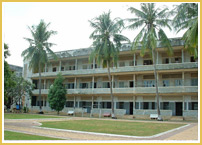 Formerly the Chao Ponhea Yat High School, named after a Royal ancestor of King Norodom Sihanouk, the five buildings of the complex were converted in August 1975, four months after the Khmer Rouge won the civil war, into a prison and interrogation center. The Khmer Rouge renamed the complex "Security Prison 21" (S-21) and construction began to adapt the prison to the inmates: the buildings were enclosed in electrified barbed wire, the classrooms converted into tiny prison and torture chambers, and all windows were covered with iron bars and barbed wire to prevent escapes. From 1975 to 1979, an estimated 17,000 people were imprisoned at Tuol Sleng (some estimates suggest a number as high as 20,000, although the real number is unknown). At any one time, the prison held between 1,000-1,500 prisoners. They were repeatedly tortured and coerced into naming family members and close associates, who were in turn arrested, tortured and killed. In the early months of S-21's existence, most of the victims were from the previous Lon Nol regime and included soldiers, government officials, as well as academics, doctors, teachers, students, factory workers, monks, engineers. Formerly the Chao Ponhea Yat High School, named after a Royal ancestor of King Norodom Sihanouk, the five buildings of the complex were converted in August 1975, four months after the Khmer Rouge won the civil war, into a prison and interrogation center. The Khmer Rouge renamed the complex "Security Prison 21" (S-21) and construction began to adapt the prison to the inmates: the buildings were enclosed in electrified barbed wire, the classrooms converted into tiny prison and torture chambers, and all windows were covered with iron bars and barbed wire to prevent escapes. From 1975 to 1979, an estimated 17,000 people were imprisoned at Tuol Sleng (some estimates suggest a number as high as 20,000, although the real number is unknown). At any one time, the prison held between 1,000-1,500 prisoners. They were repeatedly tortured and coerced into naming family members and close associates, who were in turn arrested, tortured and killed. In the early months of S-21's existence, most of the victims were from the previous Lon Nol regime and included soldiers, government officials, as well as academics, doctors, teachers, students, factory workers, monks, engineers. |
|
|
|
|
|
|
|
|